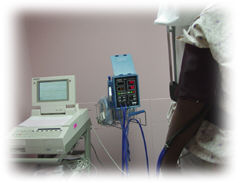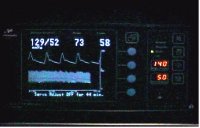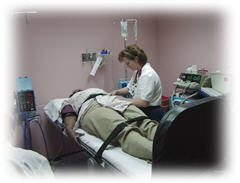|
Tilt
Test:
What is a Tilt
Test?
A Tilt Table Test or TTT is
widely used in making the diagnosis of Neurally Mediated Syncope or
NMS. Both of them are discussed below.
What is NMS and why do these patients pass
out?
NMS is a condition that can
occur in a wide range of people, many of whom do not have any other
associated cardiovascular problems. These patients give a history of
repeatedly having syncope (passing out spells) over the course of
several years. Some of these spells may be preceded by a hot
sensation or nausea but many come on without any warning. The
patient may fall to the ground and recover consciousness quickly and
without any further problems. The episodes of syncope may occur at
church, in the grocery store, while a blood specimen is being drawn,
or while sitting quietly at home, etc. Surprisingly, the majority of
the patients never sustain serious injuries and the diagnosis may go
undetected for decades. Patient's get used to having "faints" and
life goes on! The availability of the Tilt Test, its wide success in
establishing the diagnosis of NMS, and effective treatment for NMS
has resulted in the well deserved popularity of the test.
To
understand this phenomenon, we must first examine how the nervous
system of the body functions. During our daily activities, our heart
rate (HR) and blood pressure (BP) constantly rise and fall to meet
the needs of the body. The HR and BP are lower at rest, while the
HR picks up and BP is elevated during emotional stress and
exercise. The control of the HR and BP are under the domain of the
sympathetic and parasympathetic
nervous system. The former increases the HR and BP while the latter
reduces them. To simplify this concept, let us imagine that the body
is an automobile. Pressing the accelerator pedal would make the car
work harder and go faster. In contrast, pressing the brake pedal
would slow the car down. Thus, the sympathetic nervous system
behaves like an accelerator for the body while the parasympathetic
system functions like a braking system. You with me? Great!
Normally, the sympathetic and parasympathetic nervous system work
together in a very efficient and cooperative manner. Just like a
good driver, the accelerator and brake pedals are used efficiently
(one being slowly pressed while the other is smoothly released). The
car slows down and speeds up so smoothly that one does not recognize
the change. Similarly, our HR and BP goes up and down without us
being aware of it. From time to time, this system breaks down in
people with NMS. It is almost as if the accelerator pedal remains in
the control of the car driver while the braking system is
occasionally turned over to an extremely nervous "back seat driver."
This spells trouble! Now, if the "car" accelerates too rapidly (HR
and BP goes up), the back seat driver panics and SLAMS the brake.
The HR and BP (either singly or together) drop suddenly and
severely. This reduces blood supply to the brain and the patient
passes out. The back seat driver then steps off the brake pedal, the
HR and BP increases, blood flow is restored and the patient awakens.
 How is the Tilt Test Performed? The patient is
hooked to an EKG machine and a BP monitor. The HR and BP are
constantly monitored during the procedure. An intravenous (IV) line
is placed in the arm. Large patches are also applied to the
patient's chest. How is the Tilt Test Performed? The patient is
hooked to an EKG machine and a BP monitor. The HR and BP are
constantly monitored during the procedure. An intravenous (IV) line
is placed in the arm. Large patches are also applied to the
patient's chest.
 
These
patches are connected to an external pacemaker and turned on if the
patient's HR slows down and does not pick right up (in the majority
of cases the slow HR is transient and the external pacemaker is only
a precautionary measure).
 The patient lays
on a swivel table in a flat position. Safety straps are applied
across the chest and legs to hold the patient in place. The patient lays
on a swivel table in a flat position. Safety straps are applied
across the chest and legs to hold the patient in place.
 After obtaining the
baseline HR and BP, the motorized table is tilted up to an angle of
80 degrees. This simulates going from a flat (supine) to a standing
or upright position. The change in position causes the HR and BP to
rise and the patient's response is noted. After obtaining the
baseline HR and BP, the motorized table is tilted up to an angle of
80 degrees. This simulates going from a flat (supine) to a standing
or upright position. The change in position causes the HR and BP to
rise and the patient's response is noted.
Depending upon
the physician and the protocol of a given laboratory, the duration
of time spent in the supine and upright position can vary from 5 to
30 minutes.
 If nothing happens,
the table is returned to the flat position and an intravenous
infusion of isoproternol (Trade name = Isuprel) is started. This
medicine increases the HR and BP. This effect is similar to that
produced by our own natural adrenaline release. As you may have
gathered, the test is now simulating what happens when the
sympathetic nervous system is stimulated and the "accelerator" is
pressed. The tilt table is then raised back up to 80 degrees and the
IV medication continued. If nothing happens,
the table is returned to the flat position and an intravenous
infusion of isoproternol (Trade name = Isuprel) is started. This
medicine increases the HR and BP. This effect is similar to that
produced by our own natural adrenaline release. As you may have
gathered, the test is now simulating what happens when the
sympathetic nervous system is stimulated and the "accelerator" is
pressed. The tilt table is then raised back up to 80 degrees and the
IV medication continued.
 A stop
clock in the room is used to keep track of time. If an abnormal
result is not seen, the table is lowered and then raised back up
after increasing the dose of the IV medicine. In patients with NMS,
the increase in HR and BP is usually sufficient to cause "panic in
the back seat driver" (parasympathetic nervous system). When this
happens, the HR, BP or both drop suddenly and dramatically as the
parasympathetic system "slams the brake pedal.". The patient gets
dizzy and passes out. Thus, TTT succeeds in simulating a real life
situation and establishes the cause of recurrent black out spells.
With the above changes, the test is considered positive. The IV
medicine is immediately stopped and the patient returned to the flat
or supine position. Within a few seconds, the patient regains
consciousness and both the HR and BP return to normal. The patient
is observed for 10 to 20 minutes and then disconnected from the
equipment. A stop
clock in the room is used to keep track of time. If an abnormal
result is not seen, the table is lowered and then raised back up
after increasing the dose of the IV medicine. In patients with NMS,
the increase in HR and BP is usually sufficient to cause "panic in
the back seat driver" (parasympathetic nervous system). When this
happens, the HR, BP or both drop suddenly and dramatically as the
parasympathetic system "slams the brake pedal.". The patient gets
dizzy and passes out. Thus, TTT succeeds in simulating a real life
situation and establishes the cause of recurrent black out spells.
With the above changes, the test is considered positive. The IV
medicine is immediately stopped and the patient returned to the flat
or supine position. Within a few seconds, the patient regains
consciousness and both the HR and BP return to normal. The patient
is observed for 10 to 20 minutes and then disconnected from the
equipment.
How to
prepare for the Tilt test? Check with your physician to see if
any of your medications need to be held. You should not eat or drink
after midnight to reduce the risk of nausea and vomiting during the
test. Try and wear a blouse or shirt to expedite preparation for the
test.
How long does
the Tilt test take? The test generally takes a total of 1 1/2
hours. This includes preparation, the actual test and the recovery
phase. Please make sure that somebody can drive you home after the
test.
How safe is a
Tilt test? The test is fairly safe, although it can be dramatic
for the patient if the test is positive and causes a black out
spell. Not a very pleasant circumstance! However, the patient needs
to recognize that this denotes a positive response and opens the
door to the addition of extremely effective medications that may
dramatically reduce or totally eliminate the patient's recurrent
black out spells. In rare cases, the test may produce
persistent abnormal heart rhythm and patients with
coronary artery disease may occasionally experience lingering chest
discomfort. Experienced staff and equipment are on hand to handle
these potential complications.
What information is provided by the Tilt
test? The tilt test helps to confirm the diagnosis of NMS. This
is extremely important because there is effective treatment for the
condition which can either totally eradicate or dramatically reduce
the frequency and intensity of symptoms (dizziness and black out
spells). Recent research studies have also shown a correlation
between chronic fatigue syndrome (CFS) and NMS. Treatment aimed at
NMS has been shown to be beneficial in many patients with CFS (if
they have a positive tilt test). The use of beta-blockers is most
commonly employed in the treatment of NMS. The beta-blockers acts as
a "governor" on a carburetor. The motor does not "rev up" as much
(HR and BP does not increase drastically) and the back seat driver
(parasympathetic system) remains calm and does not slam on the
brakes. Other drugs that have shown benefit include aminophylline,
disopyramide and certain anti-depressants serotonin-uptake
inhibitors).
How quickly will I get
the results of the Tilt Test? The tilt test results are
generally provided to you as soon as it is completed. Changes in
your medications, if indicated by the results of the test, may be
discussed at the same time or during a subsequent office visit

-->
|